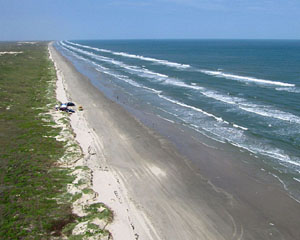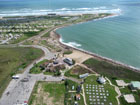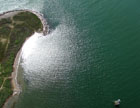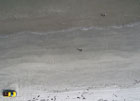
| Kite Aerial Photography
South Texas Coast
J.S. and S.W. Aber
|
Introduction
During the first week of October 2005, we had the opportunity to visit South Texas while attending a conference on aerial photography at the Kika de la Garza Subtropical Agricultural Research Center--see ARS. We took our KAP gear to demonstrate at the conference and to explore the coastal wetlands along the Gulf of Mexico. This region is a subtropical, semiarid environment located at low latitude (26-27°N). Late summer weather was still in full force at this time, with daytime temperatures into the upper 90s F (high 30s C) and isolated showers most days.
Our main subjects included Padre Island and Laguna Madre (Weise and White 1991). Padre Island is a barrier island that extends more than 100 miles (>160 km) along the South Texas coast. It is the longest barrier island in the United States. It began forming only about 2800 years ago, when sea level rose close to its modern position following the melting of Ice Age glaciers (Brown and Huey 1991). Most of the island is less than 20 feet (6 m) above sea level, although a few dunes stand up to 50 feet (15 m) high. Much of the north half of the island is protected in the Padre Island National Seashore. The remainder is privately owned.
Laguna Madre is a shallow lagoon between Padre Island and the mainland. It has quite limited connections to the open sea and little influx of freshwater from the mainland. Given the high evaporation rates, its water is quite saline. Average water depth is only 3 feet (1 m). The lagoon is subject to wind action that drives water across tidal flats around its margins. Seagrass on the lagoon bottom is a rich and productive environment with high biodiversity, and emergent wetlands on islands and margins of the lagoon are famous for shore birds and wading birds, such as the roseate spoonbill.
Laguna Atascosa National Wildlife Refuge
Laguna Atascosa NWR is located on the mainland side of Laguna Madre opposite South Padre Island. The refuge is famous for its wildlife, including sandhill cranes, ocelots, Texas tortoise, and many others. Our pictures were taken from the Laguna Madre shore on the southeastern side of the refuge.

| Overview toward the north with Laguna Madre on the right and refuge wetlands on the left. The road leads toward Plover Point parking area in the distance (where the road appears to end on a small knob). |

| Detail view of Laguna Madre shoreline. The bare strip is a wind-tidal flat marked by two bright zones: a) dead seagrass washed up during a storm and bleached in the sun, and b) foam on water margin. |

| Overview toward the northwest into the mainland of the refuge. The largely bare zone in the distance is Pelican Lake which has little water in late summer. |

| View southward to Stover Point (peninsula). Note the delicate shoals and islands along the coast. |

| View eastward showing small islands. These islands display natural crescentic outlines and enclose small lagoons. They presumably formed by wind and wave reworking of sediment from shoals and are now stabilized by vegetation. |

| Detail view of crescentic island and shallow shoals. Such islands are important bird santuaries, as predators cannot reach the islands. |

| Near vertical look at the mainland environment next to the shore. Numerous animal trails can be seen across the wetland vegetation. |
South Padre Island
South Padre Island has developed rapidly in recent years into a major tourist destination, as evidenced by many high-rise hotels and luxury condominiums. A city park at the south tip of the island offers public camping and beach access. Also a Boy Scout high-adventure camp is situated next to the park. We set up in the city park, in a vacant field next to the scout camp for KAP operation.
Upon our arrival on South Padre Island, we began to suffer many strange health effects, including serious respiratory distress and skin inflamation, some of which persisted for several days. Later we learned a red tide was underway! This was among the most unpleasant KAP episodes in our experience. The Gulf red tide of 2005 was intensified by two years of major hurricanes, which generated excessive runoff with nutrients (nitrogen and phosphorous) that fed massive algal blooms of Karenia brevis (Yauck 2006). The red tide subsided after November 2005, and did not return in force to the Texas coast in 2006 or 2007.

| View toward northwest including the Queen Isabella Causeway, which connects Port Isabel on the mainland (left) with South Padre Island (right). Laguna Madre in the background. |

| View northward showing the Coast Guard station (left center) and "downtown" South Padre Island (upper right). |

| Closeup view of the Coast Guard station on the Laguna Madre side of South Padre Island. |

| View toward northeast with Isla Bianca Park in the foreground and Gulf of Mexico in the background. |

| View eastward including entrance of the shipping channel (upper right). Laguna Station (Boy Scout) camp is visible in the lower right. The closely spaced square objects are wooden frames for tents. |

| Towboat coming through the Brazos-Santiago Pass between South Padre Island (bottom) and Brazos Island (top). |

| Towboat heading toward the Brownsville Ship Channel in the background. Note the distinctive wake pattern behind the boat. |

| Sun glint view of the south tip of South Padre Island with a navigation tower in lower right corner of scene. The shore along Brazos-Santiago Pass (top left) is protected by large granite blocks. |

| Closeup, near-vertical view of navigation tower on Laguna Madre side of South Padre Island. Note tower shadow. |
North Padre Island
More than 70 miles (110 km) of island, beach and lagoon habitats are protected in the Padre Island National Seashore. Of this, some 60 miles (95 km) are open for driving vehicles on the beach. When we visited, a major sport fishing tournament was getting underway, and fishermen were setting up their weekend camps all along the beach. Fortunately a cold front had delivered some cooler, drier air with an offshore wind, so the red tide was not present. We had a delightful time doing KAP of the island environment and fishing tournament.

| View northward along the Padre Island seashore. The Malaquite Visitor Center is visible in the center background, along with the access road that leads to the beach. |

| View across the island toward Laguna Madre in the distant background. An active blow-out dune appears to right, and wetland vegetation fills hollows to left. |

| Fishermen have set up a camp at the upper margin of the beach in preparation for a fishing tournament. |

| Low-oblique view of fishing camp as people begin to set up their fishing poles along the beach. |

| Vertical shot of beach zone. Several fishing poles are visible along the top edge of the scene. |

| Vertical view of the fishing campsite as a red truck loaded with gear drives by on the beach. |

| Closeup vertical shot of the weekend fishing campsite with vehicles, tents, coolers, a small boat, and other equipment. |
 Related sites
Related sites
References
- Brown, J.E. and Huey G.H.H. 1991. Padre Island: The national seashore. Southwest Parks and Monuments Association, Tucson, Arizona, 62 p.
- Weise, B.R. and White, W.A. 1991. Padre Island National Seashore: A guide to the geology, natural environments, and history of a Texas barrier island. Texas Bureau of Economic Geology, Guidebook 17, 94 p. (2nd printing of 1980 edition).
- Yauck, J. 2006. Hurricanes intensify red tides off Gulf. Geotimes, 51/9, p. 12.
 Return to KAP gallery.
Return to KAP gallery.
Last update: Dec. 2007.


![]() Related sites
Related sites![]() Return to KAP gallery.
Return to KAP gallery.